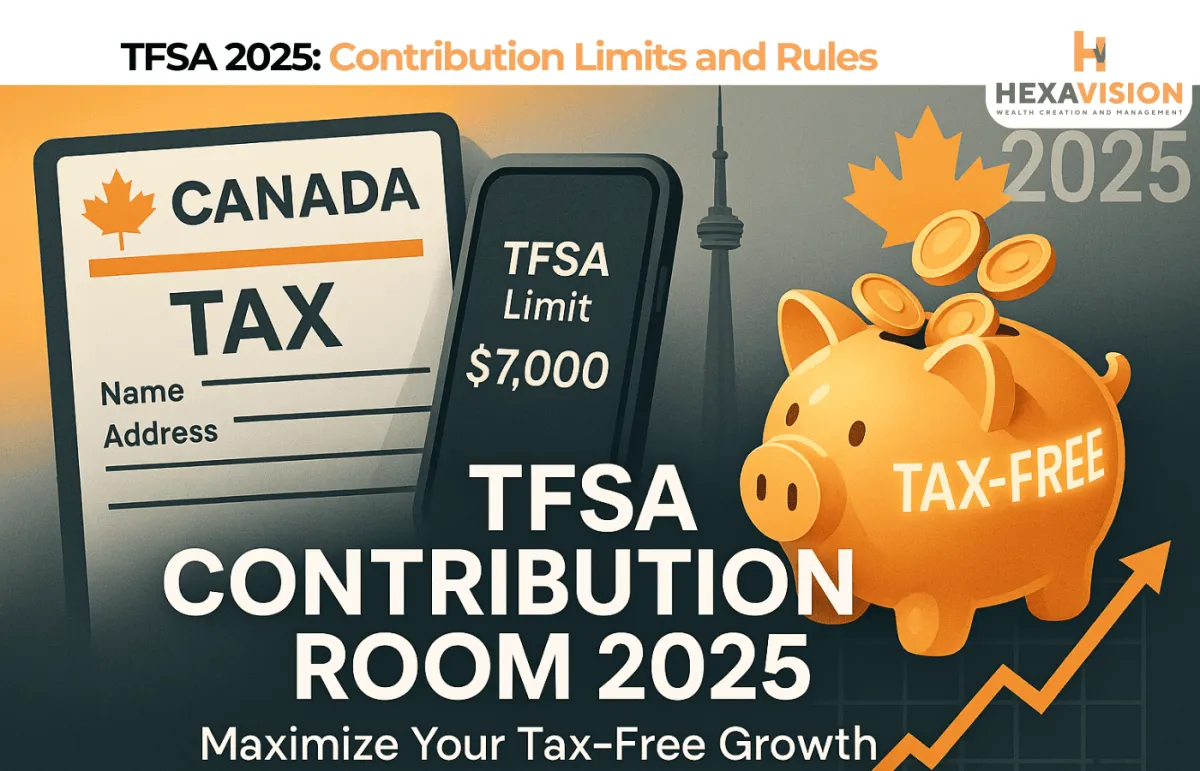
TFSA Contribution Room 2025: Key Facts You Must Know
What Is the TFSA Contribution Room 2025?
If you’re a Canadian with dreams of financial freedom—or just want to avoid that sinking feeling come tax time—the TFSA Contribution Room 2025 is your ticket to tax-free growth. But what exactly is it? In short, it’s the maximum amount you can deposit into your Tax-Free Savings Account (TFSA) in 2025 without facing a penalty. This year, the government has set the annual limit at $7,000, matching the 2024 figure and marking the second-largest annual allowance in TFSA history.

But here’s the kicker: if you’ve never contributed and were eligible since TFSAs launched in 2009, your cumulative TFSA contribution room by 2025 is a whopping $102,000. That’s enough to make even the most frugal saver’s heart skip a beat.
How Much Can I Contribute to TFSA in 2025?
Let’s cut to the chase: how much can I contribute to TFSA in 2025? The answer is $7,000 for the yea But that’s just the annual limit. Your personal contribution room could be much higher, thanks to unused room from previous years and amounts you withdrew in 2024 (which are added back for 2025).
Quick math:
If you turned 18 in 2009 and never contributed, your total room for 2025 is $102,000.
If you contributed less than the annual limit in any year, the unused amount carries forward indefinitely.
If you withdrew $3,000 in 2024, you can re-contribute that $3,000 on top of your 2025 limit.
Pro tip: Always check your exact TFSA contribution room by logging into CRA MyAccount or calling the Tax Information Phone Service (TIPS).
Understanding TFSA Contribution Rules for 2025
The TFSA Contribution Room 2025 rules aren’t just about a number—they’re about how you use them. Here’s what you need to know:
Eligibility: Any Canadian resident aged 18 or older with a valid SIN can open and contribute to a TFSA.
Multiple Accounts: You can have more than one TFSA, but your total contributions across all accounts must not exceed your available room.
Carry Forward: Unused contribution room from previous years carries forward indefinitely.
Withdrawals: Amounts withdrawn in 2024 are added back to your 2025 room—but only in the following year, not immediately.
Penalties: Over-contributing results in a 1% monthly penalty on the excess amount until it’s withdrawn.
Let’s be honest: the rules can feel like a maze. One wrong turn, and you’re on the hook for penalties. But with a little diligence (and maybe a spreadsheet), you can stay on track.
TFSA Carry Forward Rules and Unused Room Explained
Ever feel like you missed the boat on contributing in past years? Good news: the TFSA is remarkably forgiving. Unused TFSA room explained: Any unused contribution room from previous years is automatically carried forward, increasing your future limit.
Example:
Suppose you contributed only $3,000 in 2024 (when the limit was $7,000). That leaves $4,000 unused. In 2025, your new room is $7,000 (the annual limit) + $4,000 (unused from 2024) = $11,000.
Key points:
There’s no deadline for using unused room—it accumulates for as long as you’re eligible.
Withdrawals are added back the following year, not immediately.
The CRA tracks your room, but delays can occur, so keep your own records for peace of mind.
Inflation-Adjusted TFSA Limits: How They’re Set
Ever wonder why the TFSA limit sometimes jumps by $500, and other times stays flat? It’s all about inflation. The annual limit is indexed to inflation, rounded to the nearest $5002. In years when inflation is moderate or high, you might see a jump; when it’s low, the limit can remain unchanged.
For 2025:
The limit is $7,000, unchanged from 2024, reflecting a period of stable inflation.
In the past, the limit has increased in $500 increments, except for 2015’s one-time $10,000 spike.
Why does this matter? Because over time, these inflation-adjusted TFSA limits protect your savings power. But if inflation outpaces the limit increases, your real savings potential could erode—a subtle risk for long-term planners.
CRA TFSA Rules 2025: Eligibility and Tracking
Let’s talk eligibility. To contribute to a TFSA in 2025, you must:
Be a Canadian resident
Be at least 18 years old
Have a valid Social Insurance Number (SIN).
Tracking your room:
Log in to CRA MyAccount for Individuals
Use the Tax Information Phone Service (TIPS) at 1-800-267-6999
Consult your annual CRA TFSA statement.
Caution: The CRA’s records can lag behind real-time contributions and withdrawals. If you’re juggling multiple accounts or financial institutions, double-check your own records to avoid accidental over-contributions.
TFSA vs RRSP: Which Is Better for 2025?
In 2025, the TFSA contribution limit is $7,000, while the RRSP limit is 18% of your earned income, up to a maximum of $32,490. Contributions to a TFSA are not tax-deductible, meaning they don’t reduce your taxable income, whereas RRSP contributions are deductible, helping you lower your taxes in the year you contribute.
When it comes to withdrawals, TFSA withdrawals are completely tax-free, while RRSP withdrawals are taxed as income, with some exceptions like the Home Buyers' Plan or Lifelong Learning Plan. Both accounts allow you to carry forward unused contribution room, but age limits differ—there’s no age limit for a TFSA, whereas RRSPs must be converted to a RRIF or annuity by age 71. Lastly, TFSAs offer flexible access, allowing you to withdraw funds anytime without tax consequences, unlike RRSPs which are less liquid due to tax implications on withdrawals.
When to use a TFSA:
Saving for a home, car, or emergency fund
Expecting to be in a higher tax bracket later
Wanting flexibility and tax-free withdrawals
When to use an RRSP:
Saving for retirement
Wanting an immediate tax deduction
Expecting to be in a lower tax bracket in retirement
Ultimate Anti-AI Analysis: Does the 2025 TFSA Limit Really Help Low-Income Canadians?
Does the 2025 TFSA Limit Really Help Low-Income Canadians?
Let’s put the spotlight on four big players: CRA, 2025 contribution threshold, financial advisors, and young savers.
On the positive side, the CRA’s decision to maintain the TFSA contribution room 2025 at $7,000 gives low-income Canadians a powerful, flexible tool. Financial advisors often highlight the TFSA’s role in building emergency funds and encouraging disciplined savings, especially for those who might not have access to employer pension plans. Young savers, in particular, benefit from the ability to start small and let their investments grow tax-free over decades. The cumulative $102,000 limit for long-term eligibility means even modest annual contributions can add up to life-changing sums.
But here’s the rub: critics argue that the $7,000 annual limit is out of reach for many low-income Canadians who struggle just to cover basic expenses. The 2025 contribution threshold may look generous on paper, but if you’re living paycheque to paycheque, maxing out your TFSA is a distant dream. Some financial experts question whether the TFSA’s structure disproportionately benefits higher earners who can consistently contribute the maximum. In practice, while the TFSA is technically available to all, its biggest rewards often flow to those who need them least. Is it time for targeted enhancements or matched savings incentives for the most vulnerable? The debate continues.
Ultimate Anti-AI Analysis: Is the TFSA Contribution Room 2025 Keeping Up With Inflation?
Is the TFSA Contribution Room 2025 Keeping Up With Inflation?
Let’s highlight inflation-indexing, CRA policy, retirees, and long-term savers.
Supporters of the current system point out that the TFSA contribution room 2025 is indexed to inflation and rounded to the nearest $500, which protects savers from the silent thief of purchasing power. The CRA policy ensures that, over time, the limit rises in line with the cost of living, allowing retirees and long-term savers to preserve the real value of their tax-free nest egg. For those who plan decades ahead, this inflation adjustment is a crucial safeguard.
However, not all is rosy. In years when inflation spikes but doesn’t quite trigger a $500 increment, the real value of the TFSA limit can actually shrink. Retirees relying on their TFSA for income may find that their savings don’t stretch as far as they’d hoped. Some critics argue for more granular adjustments or even a review of the $500 rounding rule to better match inflation’s impact. As the cost of living continues to climb, the question remains: is the TFSA limit truly keeping pace, or are Canadians quietly losing ground?
Practical Strategies to Maximize Your TFSA in 2025
Ready to make the most of your TFSA contribution room 2025? Here are some expert-backed tips:
Automate your contributions: Set up monthly transfers to avoid the last-minute scramble (and that “oops, I forgot” moment).
Re-invest withdrawals: If you made a withdrawal in 2024, re-contribute it in 2025 for maximum growth.
Diversify investments: TFSAs aren’t just for savings accounts—consider stocks, ETFs, GICs, or mutual funds for higher returns.
Track your room: Use the CRA’s online tools and keep your own records to avoid over-contributions.
Think long-term: Even small, regular contributions can snowball into a sizeable tax-free portfolio over time.
Anecdote: Picture this—Alex, a 29-year-old in Calgary, set up an automatic $250 monthly transfer to his TFSA. He barely noticed the money missing, but by year’s end, he’d maxed out his 2025 limit and was well on his way to a down payment on his first home. Not bad for a “set it and forget it” strategy!
Common Mistakes: Over-Contributions and CRA Penalties
Let’s be real—nobody wants to get a stern letter from the CRA (or worse, a penalty). Yet, over-contributions are surprisingly common. Here’s what to watch out for:
Contributing above your available room: This triggers a 1% monthly penalty on the excess until it’s withdrawn.
Multiple accounts confusion: The limit applies across all TFSAs, not per account.
Misunderstanding carry-forward rules: Withdrawals are only added back the following year, not immediately.
Relying solely on CRA records: There can be reporting delays, so keep your own tally to avoid surprises.
Light sarcasm alert: If you enjoy paying unnecessary taxes, by all means, ignore your contribution room. For everyone else, double-check before you deposit!
TFSA Contribution Room 2025 FAQ
What is the TFSA contribution room for 2025?
The TFSA contribution room for 2025 is $7,000. If you’ve never contributed and were eligible since 2009, your cumulative limit is $102,000.
Can unused TFSA room be carried forward to 2025?
Yes, any unused TFSA contribution room from previous years is automatically carried forward and added to your 2025 limit.
How do I calculate my TFSA limit in 2025?
Add the 2025 annual limit ($7,000) to any unused room from previous years and any withdrawals made in 2024. Check your CRA My Account for your exact number.
Does CRA notify about TFSA over-contributions?
The CRA may send a letter if you over-contribute, but it’s your responsibility to track your room and avoid penalties
Is the TFSA better than an RRSP for saving in 2025?
It depends on your goals. TFSAs offer flexible, tax-free withdrawals, while RRSPs provide immediate tax deductions but tax withdrawals. Both have unique advantages.
